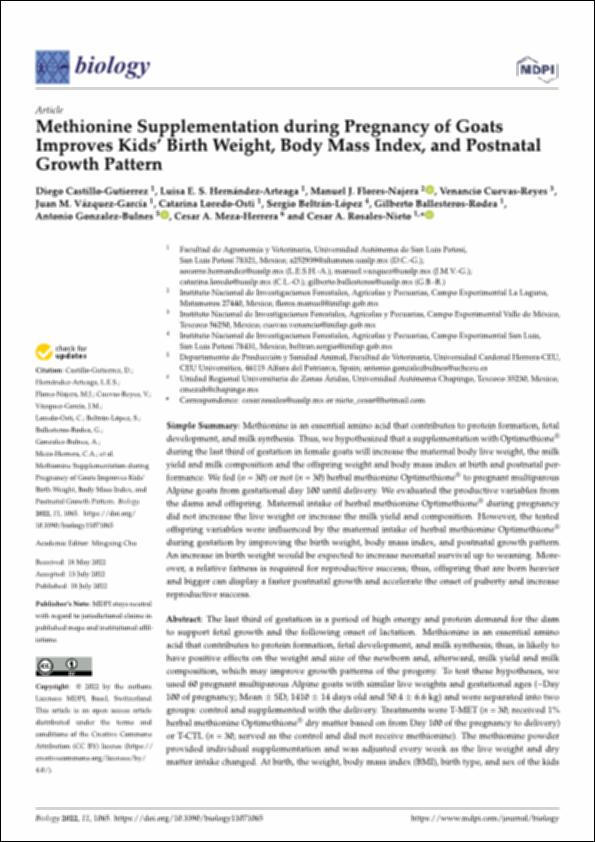Por favor, use este identificador para citar o enlazar este ítem:
http://hdl.handle.net/10637/14278Methionine supplementation during pregnancy of goats improves kids' birth weight, body mass index, and postnatal growth pattern
| Título : | Methionine supplementation during pregnancy of goats improves kids' birth weight, body mass index, and postnatal growth pattern |
| Autor : | Castillo Gutiérrez, Diego Hernández Arteaga, Luisa E. S. Flores Najera, Manuel J. Cuevas Reyes, Venancio Vázquez García, Juan M. Loredo Osti, Catarina González de Bulnes López, Antonio |
| Materias: | Pregnancy.; Aminoácidos en nutrición animal.; Amino acids in animal nutrition.; Cabras - Alimentación.; Cabras - Cría y explotación.; Gestación.; Methionine.; Goats - Feeding and feeds.; Metionina.; Goats - Breeding. |
| Editorial : | MDPI |
| Citación : | Castillo-Gutierrez, D., Hernández-Arteaga, L. E. S., Flores-Najera, M. J., Cuevas-Reyes, V., Vázquez-García, J. M., Loredo-Osti, C., Beltrán-López, S., Ballesteros-Rodea, G., Gonzalez-Bulnes, A., Meza-Herrera, C. A. & Rosales-Nieto, C. A. (2022). Methionine supplementation during pregnancy of goats improves kids' birth weight, body mass index, and postnatal growth pattern. Biology, vol. 11, i. 7 (18 jul.), art. 1065. DOI: https://doi.org/10.3390/biology11071065 |
| Resumen : | The last third of gestation is a period of high energy and protein demand for the dam to support fetal growth and the following onset of lactation. Methionine is an essential amino acid that contributes to protein formation, fetal development, and milk synthesis; thus, is likely to have positive effects on the weight and size of the newborn and, afterward, milk yield and milk composition, which may improve growth patterns of the progeny. To test these hypotheses, we used 60 pregnant multiparous Alpine goats with similar live weights and gestational ages (~Day 100 of pregnancy; Mean SD; 1410 14 days old and 50.4 6.6 kg) and were separated into two groups: control and supplemented with the delivery. Treatments were T-MET (n = 30; received 1% herbal methionine Optimethione® dry matter based on from Day 100 of the pregnancy to delivery) or T-CTL (n = 30; served as the control and did not receive methionine). The methionine powder provided individual supplementation and was adjusted every week as the live weight and dry matter intake changed. At birth, the weight, body mass index (BMI), birth type, and sex of the kids were determined. Subsequently, the progeny was weighed weekly up to weaning. Two weeks after parturition, the milk composition was recorded weekly, and the milk yield was recorded monthly. The maternal live weight at the start (Mean SEM; T-CTL: 50.5 1.1 vs. T-MET: 50.3 1.3 kg) and end (T-CTL: 54.2 1.3 vs. T-MET: 52.8 1.4 kg) of the experiment did not differ statistically among treatments (p > 0.05); however, daily live weight changes tended to differ between groups (T-CTL: 73 10 vs. T-MET: 51 7 g day1; p = 0.06). The birth weight (T-CTL: 3.1 0.1 vs. TMET: 3.5 0.1 kg; p < 0.001), daily live weight change (T-CTL: 121 6 vs. T-MET: 141 6 g day1; p < 0.01), and weaning weight (T-CTL: 8.3 0.2 vs. T-MET: 9.3 0.3 kg; p < 0.01) differed between treatments. The BMI at birth (T-CTL: 0.28 0.01 vs. T-MET: 0.3 0.01 units kg m2; p < 0.01) and at weaning (T-CTL: 0.85 0.1 kg vs. T-MET: 1.00 0.06 units kg m2; p < 0.05) differed between treatments. Milk components (protein, fat, lactose, and solids non-fat) and milk yield were similar between treatments (p > 0.05). It is concluded that the inclusion of methionine in the maternal goat diet during the last third of gestation increases the birth and growth variables of the progeny but without significant influence on the milk yield and composition. |
| Descripción : | Este artículo se encuentra disponible en la siguiente URL: https://www.mdpi.com/2079-7737/11/7/1065 Este artículo de investigación pertenece a la sección "Physiology". En este artículo de investigación también participan: Sergio Beltrán-López, Gilberto Ballesteros-Rodea, Cesar A. Meza-Herrera y Cesar A. Rosales-Nieto. |
| URI : | http://hdl.handle.net/10637/14278 |
| Derechos: | http://creativecommons.org/licenses/by/4.0/deed.es |
| ISSN : | 2079-7737 (Electrónico) |
| Idioma: | es |
| Fecha de publicación : | 18-jul-2022 |
| Centro : | Universidad Cardenal Herrera-CEU |
| Aparece en las colecciones: | Dpto. Producción y Sanidad Animal, Salud Pública Veterinaria y Ciencia y Tecnología de los Alimentos |
Los ítems de DSpace están protegidos por copyright, con todos los derechos reservados, a menos que se indique lo contrario.


